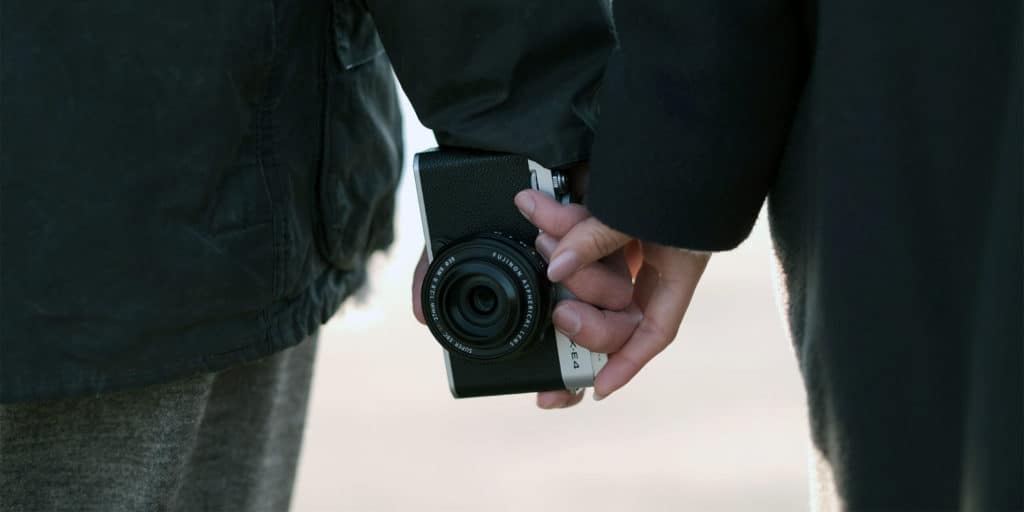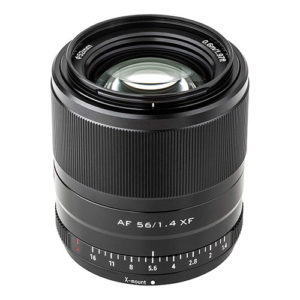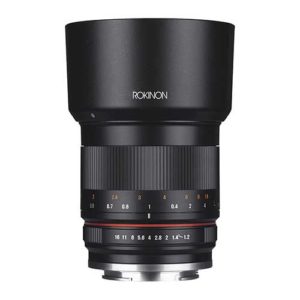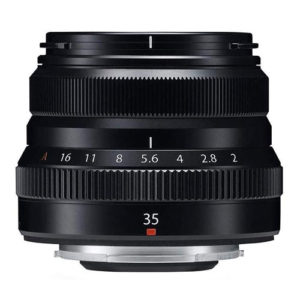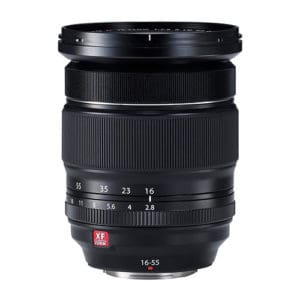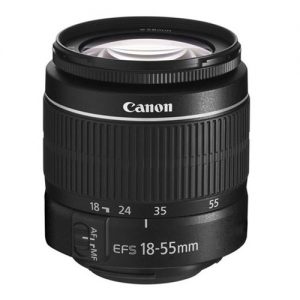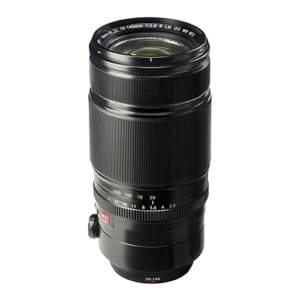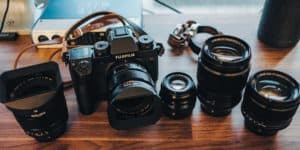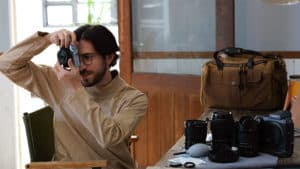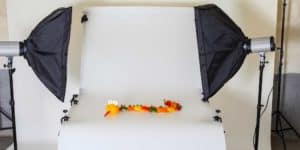The Fujifilm X-E4 is a darling of a little camera. It’s slim and sexy, and its 26 MP CMOS sensor does a bang-up job.
But the real lure of Fuji’s APS-C camera lineup is undoubtedly the awesome collection of Fujinon glass they have assembled.
Portrait photographers love this camera, and they aren’t wanting for choice when it comes to lenses.
Fujinon makes several options for portraits of all types. No matter what your style of shooting, there’s the perfect x-mount portrait lens for your fuji camera.
Let’s take a closer look at the best options.
Fujinon makes two nearly identical lenses for portrait work on your X-mount camera.
The difference is that one of them features an advanced APD (apodization) filter.
The purpose of the filter is to smooth out the already silky smooth bokeh that the lens makes.
It’s an expensive option, but if you’re a working photographer who regularly cuts your chops in the portrait game, you’ll want to shell out the bucks for the APD.
It’s not all good news here, though. The APD filter cuts down a little bit of light transmission, just like all filters do.
That means you can never really use the lens to the full potential of that beautifully wide f/1.2 aperture.
If the light-catching ability is more important to you than the overall bokeh quality, check out our runner-up below.
Fujinon makes the same lens but without the APD filter.
It’s an outstanding lens, and the bokeh it makes is gorgeous, even without the help of the snazzy filter.
The non-APD version is about $500 cheaper, too.
I like the non-APD version a little bit better for my bag, not because it saves me money, but because it makes the lens a little more versatile.
The difference in bokeh is slight, and I’m more often searching for that extra stop of light.
If you’re looking for a budget portrait prime, check out the Viltrox 56 mm f/1.4.
It’s not quite as fast as the Fuji, and it’s certainly not nearly as sharp, but it’s perfectly functional for the hobbyist or amateur.
Viltrox also makes a 23, 33, and 85 for the X-mount. Their autofocuses aren’t the best, but the newer versions of their lenses have some good glass in them.
Overall, the lens is a middle-of-the-road entry-level lens in terms of quality, but it’s worth mentioning it since it’s one of the only after-market lenses available for the X-mount.
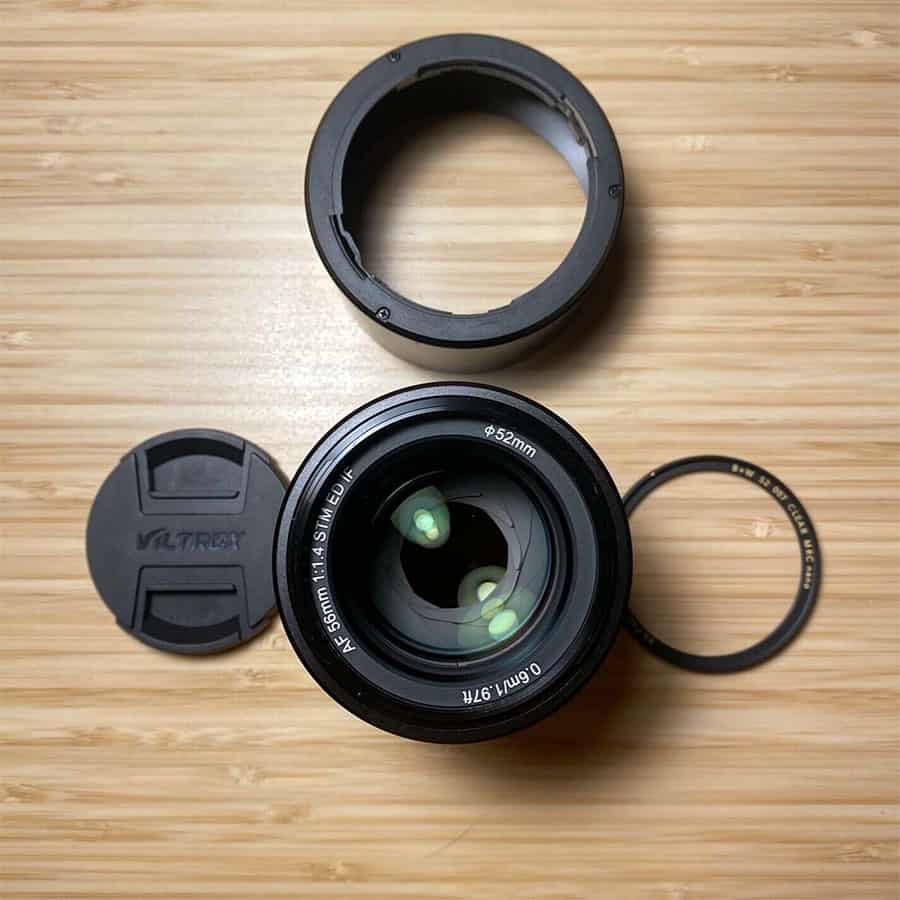
If you need a bargain lens and you need autofocus, the Viltrox is your only choice. But if you don’t mind going for a manual focus lens, check out the Rokinon.
Are you longing for the good old days, when you paid for good glass and none of these electronic bells and whistles?
Well, the folks over at Rokinon have been listening. The company has been putting out some beautiful manual focus lenses for a while now, and one of their shining stars is perfect for portraits.
With a 35 mm equivalency of 75 mm, this f/1.2 super-fast lens is what you’ve been dreaming of.
Old school, fully manual focus and aperture work perfectly on your camera, and the bokeh is smooth and creamy.
It’s just not possible to find a faster, sharper lens at this price point.
While it’s apparent that you’re going to have to focus this lens manually, there are a few other things you’ve got to keep in mind.
You can’t use a program or shutter priority mode either because these require the camera to control the lens. Portrait photographers are likely to live in aperture mode anyway, so that shouldn’t be a problem.
But also keep in mind that this lens doesn’t transmit any data to the camera at all.
The camera needs to be set to “shoot without lens” to work at all, and your files will not record the lens info in the EXIF file metadata.
Many portrait photographers like to have a 50 mm normal prime lens in their camera bags. `
It’s one of the most versatile focal lengths–it’s not only good for portraits but does nature, landscapes, still lifes, and street photography equally well.
A bonus is that 50 mm are usually fairly fast and fairly inexpensive.
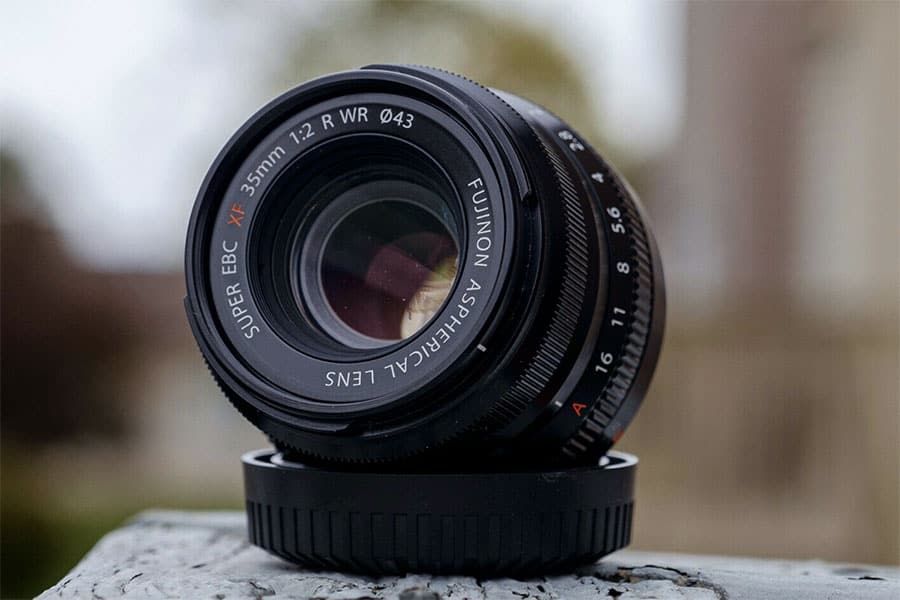
On an APS-C cropped sensor camera like the X-E4, a 50 mm perspective is achieved with a lens somewhere in the neighborhood of 33 mm.
A 35 mm lens fits the bill nicely, and Fujinon’s XF 35 mm f/2 R WR is a beautiful example.
This is a gorgeous lens–it’s fast, sharp, and it looks great too.
The lens is available in black or silver, and the silver looks great mounted on the X-E4.
It’s weather-sealed and features Fuji’s Nano-GI coating for reduced ghosting and aberrations.
There are actually quite a few good choices in this focal length range. If the XF version seems a little pricy, or you are specifically looking for a knock-about lens for a rough journey, take a look at the Fujinon XC 35 mm f/2.
The XC series of lenses feature less expensive plastic construction and ditch the dedicated aperture ring.
Another interesting option is the Viltrox 33 mm f/1.4. Like the 56 mm Viltrox I discusses above, the 33 mm is an entry-level bargain lens. Its autofocus isn’t great, and it’s not that sharp.
It is priced well, so if you’re picking it up for the odd job or can’t quite spring for the Fujinon, it’s got you covered. This lens is faster than the Fuji options, but still relatively svelt at only 270 grams.
Portrait photographers rarely reach for wide-angle lenses, but when you need one, you need one.
The APS-C sensor does us no favors at these focal lengths, but luckily Fuji offers several very wide options to fill in the gaps.
Portrait photographers generally avoid anything wider than 35 mm for general use, and to get 35 mm on your APS-C X-E4 will require something in the neighborhood of 23 mm.

Both Fuji and Viltrox make nice, wide, and fast 23 mm f/1.4 lenses. Many shooters are pleasantly surprised by the sharpness of the Viltrox.
It gets glowing reviews and praise for its sharpness and lack of distortion. But the Fujinon is no slouch and is one of the nicest lenses that Fuji makes for the X-mount.
This lens is right in the sweet spot for me–I love a 35 mm lens for its versatility and image quality. So for me, I’ll gladly hand over my credit card digits for that pretty little Fujinon.
My pick for the best portrait zoom is the XF 16-55 mm f/2.8 LM WR because it’s the fastest.
Wide open at f/2.8, it makes a pleasant bokeh and is fast enough for whatever you throw at it.
But honestly, that’s not the right reason for everyone.
I also really appreciate a walk-around portrait lens with a slim profile that is lightweight in my camera bag.
The Fujinon XF 16-80 mm f/4 R OIS WR fits the bill nicely.

It gives you just a little more reach on the telephoto end and shaves off a few grams in our camera bag.
Plus, the f/4 has optical image stabilization (OIS), a wonderful feature on all-day walk-around lenses.
Another great option saves you a little money and gives you the best of both worlds. The Fujinon XF 18-55 mm f/2.8-4 R LM OIS captures the essence of what a walk-around lens should be.
It ditches the constant aperture, but f/2.8 to f/4 is still nothing to balk at.
A wide-angle zoom for portraits?
You bet!
The wide shot is underrated in portraiture, but these images can easily be the most impactful when shooting on location.
The trick is to avoid going too wide and make sure that the subject is actively part of their background.
There was a time a few years back when wide-angle zoom lenses weren’t worth looking at.
They were generally very pricey for something that made so much distortion–a very disappointing combination.
But those days are long gone. Now, we’re left wondering what to do with all of our wide-angle primes.
The XF 8-16 mm f/2.8 R LM WR is the widest lens you can get for the X-mount at the moment. It’s a drop-dead gorgeous lens that will wow you every time you put it on your camera. It’s sharp throughout its range down to f/2.8.
I love that it’s fast, and I love the field of view. But this is a pretty wide lens for portraits, and you have to be careful to avoid unsightly distortions near the edges. The lens is very good, but anything this wide is bound to do some funny things to your subjects.
This lens’s only downsides are its price and weight. It’s hefty, large, and nearly $2,000.
If you don’t need that much speed and can sacrifice a little bit of the viewing angle, the Fujinon XF 10-24 mm f/4 R OIS WR is yet another superb lens.
Ok, this is not generally considered a portrait lens. But if your kit consists of zoom lenses and you have the 18-55 mm f/2.8, you will want to give this one a serious look.
There are many times when you’re going to want to frame subjects with something more than 55 mm, and the perspective shifts you get at these higher focal lengths can be a lot of fun to play with.
The constant aperture and optical image stabilization make this a beauty of a lens for many purposes.
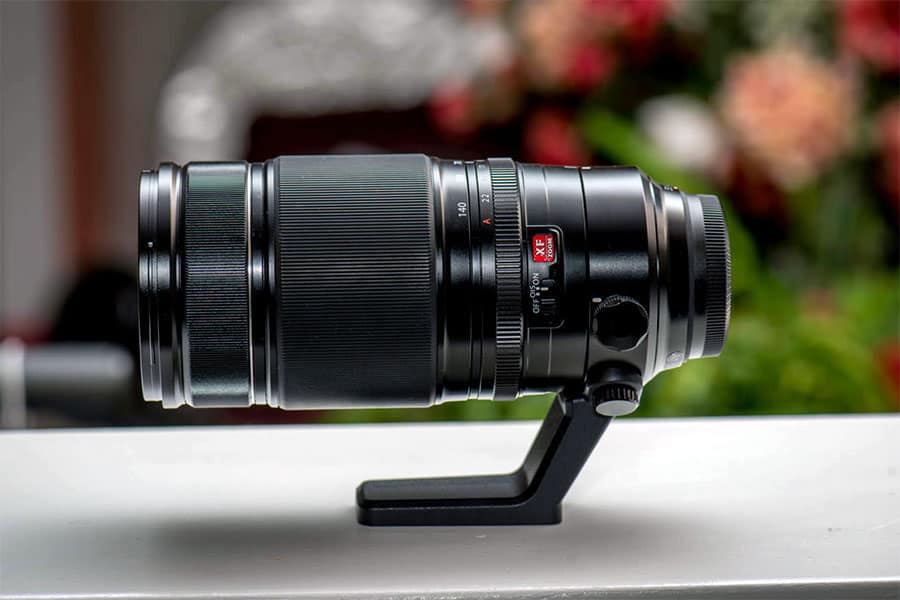
X-E4 Portrait Photographer's Guide
What Portrait Lenses Do I Need For My Fujifilm X-E4?
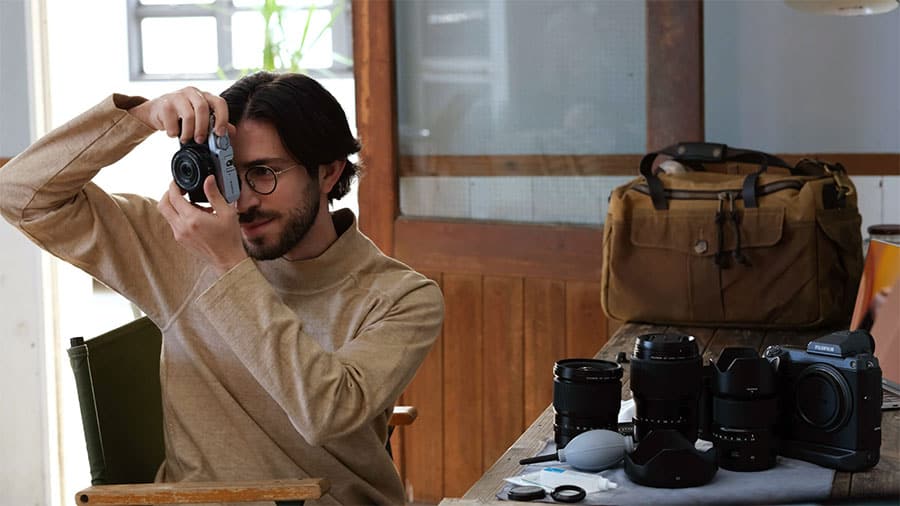
There are several different tactics that photographers can take to equip their cameras with the lenses they need.
Some photographers like to be ready for anything, and a set of high-quality zoom lenses can allow them to cover every focal length they need to shoot.
For example, with three lenses–the Fujinon XF 8-16 mm f/2.8, 16-55 mm f/2.8, and the 50-140 mm f/2.8–a photographer would have every conceivable focal length they ever needed and a constant and fast f/2.8 aperture over the entire range. That kit would solve all of your problems, but it would also be quite a lot of money to sink into your camera.
A more common approach would be to pick up a useful zoom that can do everything, like the less expensive and smaller Fujinon XF 16-80 mm f/4. This is a beautiful lens on the X-E4.
Then, as you start working in a specific area, you can pick up specialty lenses that do that one thing better than anything else.
With the 16-80 mm f/4 and the XF 56 mm f/1.2, you’ve got a killer portrait kit that will solve 90 percent of your shooting problems.
If primes are your game, get the Fujinon XF 56 mm f/1.2 and then however many other primes you need to accomplish your other favorite compositions. My next choice would be the 23 mm f/1.4, followed by the 35 mm f/1.4.
Recommended Focal Lengths and Apertures for Portraits with Fuji APSC sensors
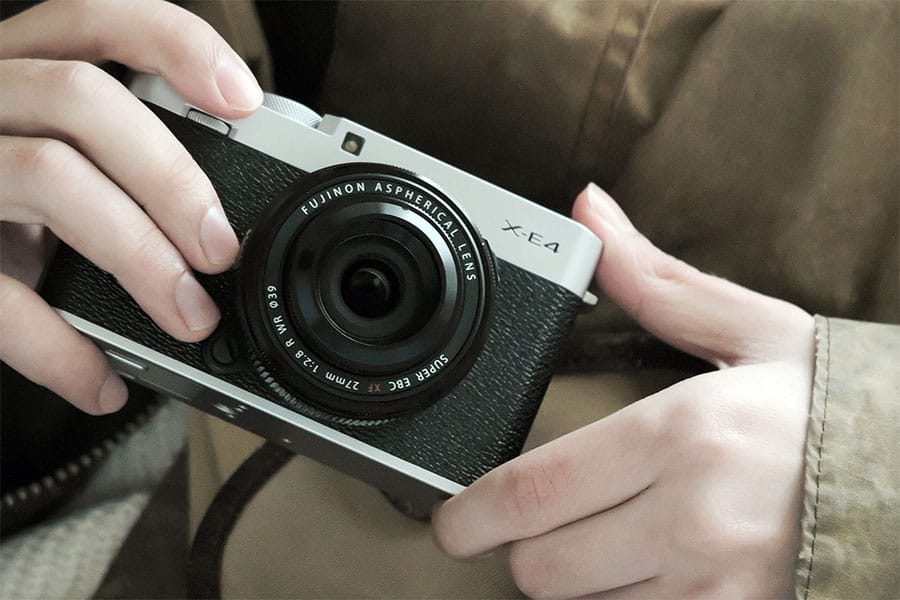
Here are a rough idea and breakdown of various lens focal lengths.
All focal lengths mentioned are in 35-millimeter equivalent terms. To figure out what size of lenses to get for the X-E4, divide each by 1.5.
- Ultra-Wide-Angle, approximately 8-20 mm
These lenses are great for landscape photography or shooting the interiors of buildings. The field of view is huge, but things must get distorted for the lens to bend so much light onto your image sensor. Some ultra-wide-angle lenses leave this effect in full force, and they are called fisheye lenses because they look like you shot them through a fishbowl. Other lenses have much less noticeable distortion. The problem with using these lenses for portraits is that they often distort the subject’s body. Legs and arms can look larger than the torso, and so on. These can be useful for doing shots of large groups or gatherings, however. - Wide-angle Lens, approximately 24-35mm
The most common wide-angle focal length is 35 mm, closely followed by 28 mm. A 35 mm lens allows you to capture full or half-body portraits easily and produce a pleasing image without much distortion. - Normal Lens, 50 mm
A 50 mm lens has the interesting quality of producing an image very close to how our eyes see the world. That means that perspectives will not be distorted and that it’s a convenient lens to have for shooting nearly anything. If you have just one lens in your bag, many people suggest it should be a 50 mm. These lenses also have the advantage of being less expensive to make. - Telephoto Lens, approximately 85-135 mm
Lenses above 50 mm are referred to as telephotos because they enlarge the object for close-ups. An 85 mm lens is the most common lens for portraits and headshots because this lens produces a very pleasing distortion and flattening of the image. Objects in the background tend to look closer, and all the image qualities come together here for that classic portrait look. - Super-Telephoto Lenses, approximately 150 mm or more
Portrait photographers rarely use this sort of lens. For sports or wildlife photography, you need to get a high-powered telephoto lens. Anywhere in the 200-400 mm range is a good place to start. You can also add tele-extenders to your lens that will boost the magnification.
The lens aperture is a more complicated matter. In general, you want lenses that have the widest apertures possible.
The aperture is the iris in the lens that opens and closes to let more or less light in.
Besides controlling the amount of light, it is also responsible for controlling the image’s depth of field.
Wide-aperture lenses give the photographer more options for shooting in low light, and they also allow for the creative control of making shallow depths of field.
But, wide-aperture lenses are more expensive, larger, and much heavier than a lens with a smaller aperture.
Zoom lens designs often save money by having a diminishing aperture as the photographer zooms in.
Higher quality lenses will have constant wide apertures throughout the lens’s zoom range.
Prime Versus Zoom Lenses
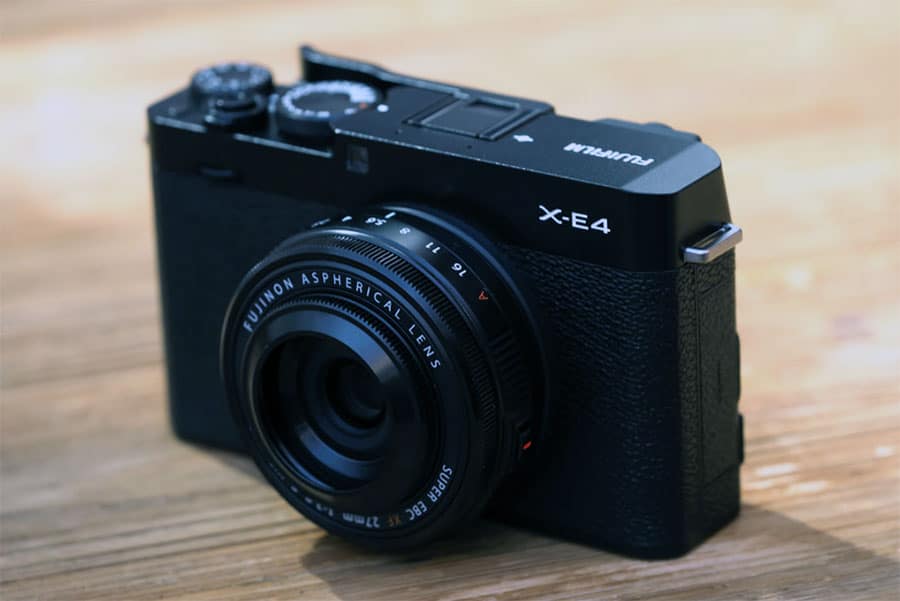
A prime lens has a fixed focal length, while a zoom lens has adjustable focal lengths.
The most common advice regarding what type of lens to buy is that prime lenses are often cheaper and offer better optics than zooms.
This is true, and you will find faster prime lenses for less money.
But truthfully, zoom lenses have gotten very good. Most photographers appreciate the convenience of having one or two lenses do everything.
A prime lens might be smaller and lighter, but a zoom lens can do the job of three or four primes.
In the end, it’s more of a style choice.
A prime lens forces a photographer to move around a little bit more, which might be an advantage in helping them find creative and different angles and perspectives.
On the other hand, zoom lenses are trusted by professionals like wedding photographers.
A zoom allows you to be across the room and frame an image as you need to without moving.
Fujifilm Lens Codes
Like all lens and optics manufacturers, Fuji has a detailed labeling system to classify their different lenses. Fuji lenses are sold under the legacy brand name Fujinon.
The X-E4 uses Fuji X-mount lenses which also fit other Fujifilm APS-C sensor cameras.
Of the X-series lenses, there are two classifications.
- The XF models are the best ones, with all-metal barrel construction and dedicated aperture rings.
- The XC lenses are designed as entry-level or bargain options. Their construction is less robust, but they are lightweight and less expensive.
Fujinon also sells lenses for the G-mount on the GFX series of cameras. These are larger lenses built to suit these camera’s larger sensors. The GFX cameras are medium format.
The absolute top-of-the-line Fujinons are called “Red Badge” lenses. Like Sony has their G-Master series and Canon has their L-series, these lenses are the best options that Fuji manufactures.
They have the fastest apertures available and the best optics.
Here are some of the other codes you might see associated with Fujinon lenses.
OIS–optical image stabilization
These lenses have a built-in system to reduce camera shake at low shutter speeds. They’re most useful when coupled with telephoto lenses, but the technology is great for low-light, hand-held shooting of every kind.
WR–weather-resistant
WR lenses are sealed against the elements better than other options. This is especially handy on lenses since moisture condensation caused by temperature differences can get inside the optics and cause mold and mildew that you cannot clean. Theoretically, WR lenses should last longer with fewer of these optical blemishes.
R–aperture ring
Some Fujinon lenses are sold with a physical aperture ring, and others are not. This is unique to Fuji since Canon, Nikon, and others have replaced the physical ring with electronically controlled ones. The ring has a nice classic feel for photographers who like to ditch all the automation and stick to the basics.
LM–linear motor autofocus
The linear drive autofocus motors deliver silent operation and smooth, fast autofocus. If a lens isn’t marked as LM, then the autofocus uses a coreless DC motor.
APD–apodization filter
Only available on the XF 56 mm f/1.4 R APD, the apodization filter is used to increase the quality of the bokeh for portrait photographers.
Macro
These lenses are designed for close focusing to capture very tiny objects; in other words, they are for capturing extreme close-ups. To qualify as a macro lens, the optics have to present a 1:1 image to the sensor. Macro photography is a niche photography genre all to its own.
EBC–electronic beam coating
This is a Fujinon brand name for a high-tech optical coating used to reduce ghosting and lens flare. Most manufacturers have similar products, but the name varies considerably.
Nano-GI–gradient index
A high-tech coating that some lenses have to change the refractive index between the glass and the air between the lens elements. The benefit is a reduction in ghosts and flare from light that enters diagonally.
Understanding Crop Factor and Sensor Size
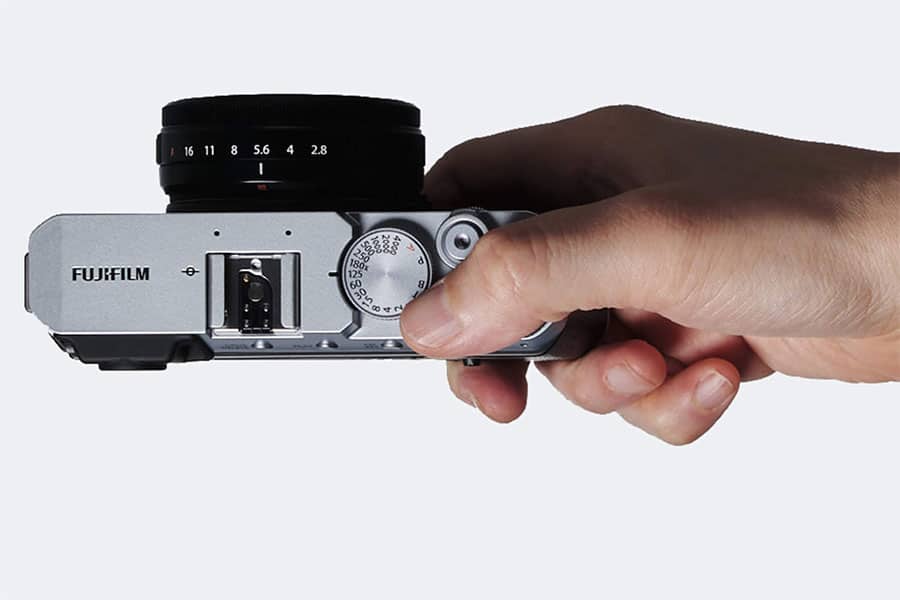
All lenses are sold with focal lengths marked as they would be for a full-frame 35 mm film negative.
Unfortunately, only a few high-end cameras have film sensors this size. The Fujifilm GFX lineup has sensors larger than a 35 mm full-frame, and the FX cameras have smaller sensors.
The X-mount cameras have a standard APS-C size sensor. Since this is smaller than 35 mm, you must correct the focal length you see on your lens to understand how that lens will work on the X-E4.
The X-E4’s crop factor is 1.5x. So, a 50 mm lens will work as if it were a 75 mm lens. If you want a nifty-fifty for the X-E4, you need to buy a 33 mm.
When working with telephoto lenses, a crop factor like this usually helps you out. Most of the time, you want a longer telephoto lens than you have, so getting an extra 1.5x out of your lens is a bonus!
But for wide-angle photography like landscapes, the crop factor can be discouraging. To get a wide-angle 24 mm lens, you need a 16.
Luckily, since Fujinon is making lenses native to the format, some options go down to 8 mm.
About third party lenses
The short answer is yes, you can. But the technicalities get a little more complicated.
Only a tiny handful of third-party manufacturers are making anything for the X-mount.
It’s still relatively new, with a small market share. As more people buy into the Fuji system, you might start to see more options.
At the moment, the options available are bargain lenses. Some offer surprisingly good optics, though.
It is possible to adapt other mount lenses to the X-mount. Companies like Fotodiox and Metabones make adapter tubes.
If you already have a collection of nice lenses you’d like to try on your X-E4, this is a great way to do it.
The simplest adapter tubes are for manual lenses only.
The electronic adapter connectors will give you autofocus, electronic lens control, and full use of OIS and other tools.
But these adapters cost significantly more. It’s also a good idea to double-check that the lens you want to use is fully compatible with your adapter and camera.
Fuji X-E4 Specifications
| Body type | ||
|---|---|---|
| Body type | Rangefinder-style mirrorless | |
| Sensor | ||
| Max resolution | 6240 x 4160 | |
| Image ratio w:h | 1:1, 3:2, 16:9 | |
| Effective pixels | 26 megapixels | |
| Sensor size | APS-C (23.5 x 15.6 mm) | |
| Sensor type | BSI-CMOS | |
| Processor | X-Processor 4 | |
| Image | ||
| ISO | Auto, 160-12800 (expands to 80-51200) | |
| Boosted ISO (minimum) | 80 | |
| Boosted ISO (maximum) | 51200 | |
| White balance presets | 7 | |
| Custom white balance | Yes | |
| Image stabilization | No | |
| Uncompressed format | RAW | |
| JPEG quality levels | Fine, normal | |
| Optics & Focus | ||
| Autofocus |
| |
| Digital zoom | Yes | |
| Manual focus | Yes | |
| Number of focus points | 425 | |
| Lens mount | Fujifilm X | |
| Focal length multiplier | 1.5× | |
| Screen / viewfinder | ||
| Articulated LCD | Tilting | |
| Screen size | 3″ | |
| Screen dots | 1,620,000 | |
| Touch screen | Yes | |
| Screen type | TFT LCD | |
| Live view | Yes | |
| Viewfinder type | Electronic | |
| Viewfinder coverage | 100% | |
| Viewfinder magnification | 0.93× (0.62× 35mm equiv.) | |
| Viewfinder resolution | 2,360,000 | |
| Photography features | ||
| Minimum shutter speed | 4 sec | |
| Maximum shutter speed | 1/4000 sec | |
| Maximum shutter speed (electronic) | 1/32000 sec | |
| Aperture priority | Yes | |
| Shutter priority | Yes | |
| Manual exposure mode | Yes | |
| Built-in flash | No | |
| External flash | Yes (via hot shoe) | |
| Continuous drive | 20.0 fps | |
| Self-timer | Yes | |
| Metering modes |
| |
| Exposure compensation | ±5 (at 1/3 EV steps) | |
| AE Bracketing | ±5 (2, 3, 5, 7 frames at 1/3 EV, 1/2 EV, 2/3 EV, 1 EV, 2 EV steps) | |
| WB Bracketing | Yes | |
| Videography features | ||
| Format | MPEG-4, H.264 | |
| Modes |
| |
| Microphone | Stereo | |
| Speaker | Mono | |
| Storage | ||
| Connectivity | ||
| USB | USB 3.2 Gen 1 (5 GBit/sec) | |
| USB charging | Yes | |
| HDMI | Yes (micro-HDMI) | |
| Microphone port | Yes | |
| Headphone port | No | |
| Wireless | Built-In | |
| Wireless notes | 802.11b/g/n + Bluetooth | |
| Remote control | Yes (via smartphone) | |
| Physical | ||
| Environmentally sealed | No | |
| Battery | Battery Pack | |
| Battery description | NP-W126S lithium-ion battery & charger | |
| Battery Life (CIPA) | 380 | |
| Weight (inc. batteries) | 364 g (0.80 lb / 12.84 oz) | |
| Dimensions | 121 x 73 x 33 mm (4.76 x 2.87 x 1.3″) | |
| Other features | ||
| Orientation sensor | Yes | |
| Timelapse recording | Yes | |
| GPS | None | |
Resources
Conclusion
You can’t go wrong with the Fujifilm X-E4. They’re fast and sharp–but the real advantage goes to the Fujinon lenses.
These lenses perform suberbly in all conditions, wide open and corner-to-corner. No matter what your style of shooting, you’ll find a lens you love!
What do you think the “sleeper lens” of the Fujinon lineup is? Do you think the XF 56 mm f/1.2 R APD worth the money? Let us know in the comments below, and happy shooting!

